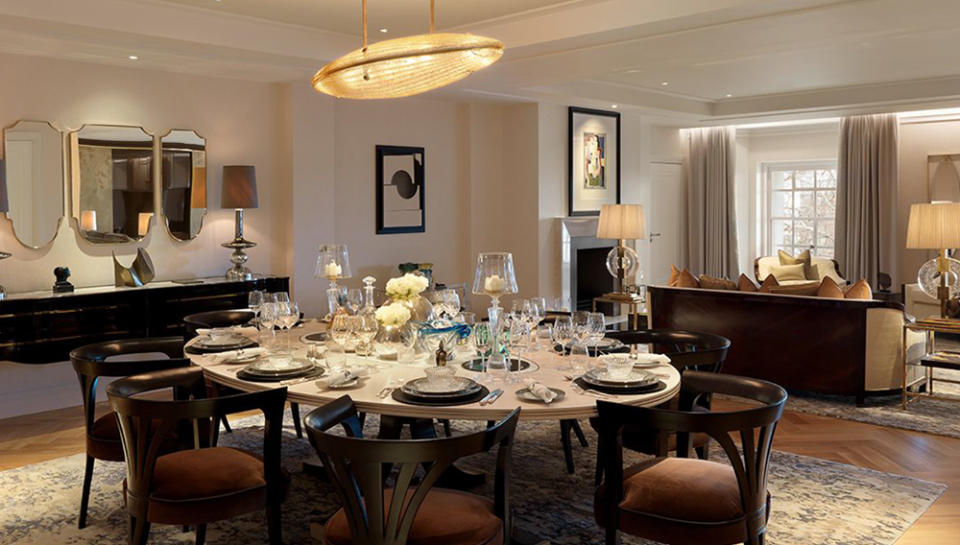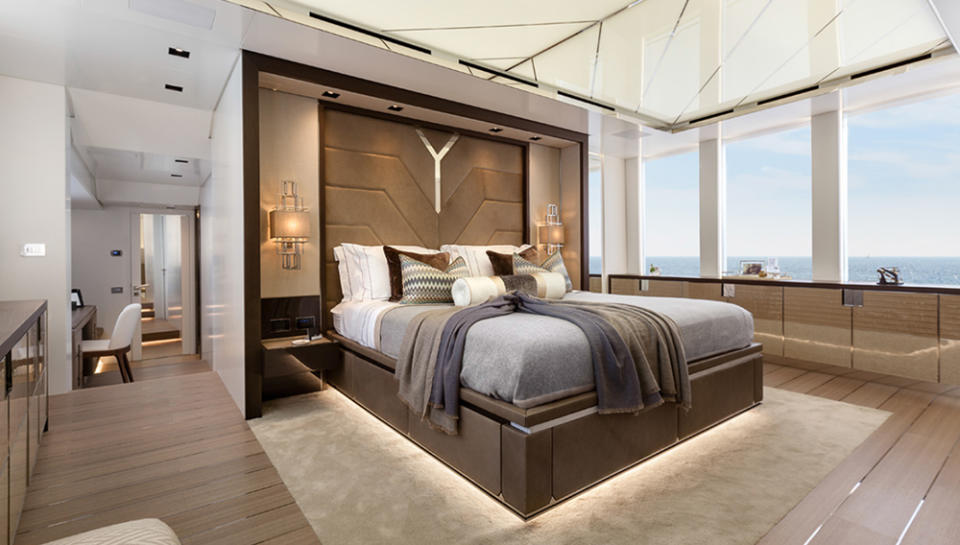Q&A with Designer Martin Kemp
From Mayfair homes and polo estates to superyachts and private jets, Martin Kemp—who has designed some one of the world’s top luxury interiors, including London’s new super-prime landmark, Ten Trinity Square, the Residences at the Four Seasons—talks to Simon Jackson, head of property at Robb Report’s editorial partner Beyond Bespoke.
Was it always your ambition to be an interior designer?
Not at all. I wasn’t academic at school—I was always the one who’d be leaning on their elbow gazing out of the window in lessons—but I was artistic. My mother was a portrait painter and my father was a planner and architect, so I had creative blood and just wanted to be painting pictures. After studying art and design in college, at the suggestion of my mother, I enrolled in a 3-D interior design course, and from there went on to work in exhibition design. In fact, during my early career I embraced lots of disciplines, from exhibitions and high-street retail to hospitality, including Chez Gerard, the Virgin Atlantic first-class airport lounge, and Yves Saint Laurent and Hugo Boss boutiques.
How did you come to move into high-end residential?
Along the way I met a friend who came from L.A., and ended up there on holiday and falling in love with the place. I vowed one day I’d live there—and that is exactly what happened. Living in Los Angeles I was exposed to high-end residential and went to work for Barbara Barry, the revered interior design in Beverly Hills. The rest is history: In 2003, I was headhunted, came back to the U.K. as creative director of Candy & Candy, and grew the business from a team of six to 120 people, the majority of whom were creatives working under my tutelage. Then at the end of One Hyde Park and La Belle Epoque penthouse in Monte-Carlo, on the brink of burnout and in need of some time out to rejuvenate, I decided to take six months off, before later setting up Martin Kemp Design (MKD). Today, five years on, we now employ 21 members of staff in our Victoria office.
The show flat you have recently created for London’s new landmark Ten Trinity Square, overlooking the Tower of London, is stunning. What appealed to you about the project?
It was of interest to us because it was one of the first super-prime developments that we’d worked on outside of Mayfair, Belgravia, or Knightsbridge. Originally we were asked to develop a scheme for the penthouse, but along the way it came to include the show flat, which is a three-bedroom apartment, with a separate kitchen, powder room, and a triple living space with premium views of the Tower of London.
What was the design brief?
The brief was to make it luxurious with a wide international appeal. The design concept is a reflection of the building itself, which was built in the 1920s and has a classical façade and detailing inside with a slight Art Deco twist.
You have worked on some incredible projects. Do you have a favorite?
There are a couple that really stand out: one a private jet, which achieved the highest accolade, in my opinion, for being described by the fashion designer
Tom Ford as the only plane he ever wanted to charter; the other a bachelor pad in Monaco that is very contemporary and dramatic and a real talking point in terms of form, color, materials, shape, light, and texture.
How do you ensure each finished project meets the exacting standards of your clients?
I have a very creative imagination and I challenge everything. Nothing ever goes out from my team as drawn—I will always turn the line two degrees or introduce a twist. And in order to educate and enthuse my team, I’ll spend my day reacting to what they draw, making a detail taller or wider, for example. Then they refine it, refine it again, and refine it a third time, before the project comes out beautifully.
How important is comfort when designing interiors?
A home needs to be comfortable emotionally and psychologically, as well as physically. You need to walk into your home and feel instantly at ease. I’ll sit in every chair, for example, to check that it’s the right height, length, depth, softness, and firmness. I’ll also quiz the owner about how they eat, whether they kick off their shoes when they walk through the door, if they throw their keys into a tray—I need to know these things and find out what they like and don’t like so we can get it right.
How much do current trends inspire your design?
I tend to avoid trends and prefer the timeless, especially in terms of color palette. When it comes to form, to some extent it is informed by architecture—I have always loved Carlo Scarpa, Louis Kahn, Kendrick Kellogg, and Olson Kundig, whom I encountered at Barbara Barry, as well as the highly revered American architect John Lautner.
How important is British craftsmanship to you?
Whether it’s carpet or hand-painted wallpaper, we endeavor to keep trade here in the U.K., and work with many homegrown companies, from the design practice Haberdashery, with whom we make fabulous light installations, and Based Upon, which creates handcrafted furniture, to the bespoke joinery and furniture companies Bill Cleyndert and Interior-iD. I appreciate the question of wealth is a controversial one for many people, but I always say it filters back to the craftspeople who keep these traditions of craftsmanship alive.
As well as private jets, you’ve designed interiors for many superyachts. How does it differ from working on a traditional home?
Superyacht interiors tend to be much more of a holiday style. Most clients, although not all, associate being on their yachts with relaxation and holidays, so there is an emotional change in design style. The textures and material change and the schemes tend to be a little lighter, sunnier, and more frivolous.
Naturally, being a boat with a lot of motion, we try to avoid sharp corners, and it goes without saying that you can’t have swinging chandeliers. [We recently worked] on a soft refit for Roman Abramovich’s former superyacht, Ecstasea.
One of your recent projects has been a private polo club in Saint-Tropez. Can you tell us about that?
Our client is a polo player himself and wanted to create the world’s best polo club. Having flattened the original establishment, he has rebuilt it as an equestrian center, with brand-new facilities for all the horses, and our brief was to design the bar and restaurant area, and the three private villas on the estate.
Do you have any other exciting projects you recently worked on?
We have 77 South Audley Street, Mayfair, seven bijoux apartments by Luxlo; we are also completing a large private home in Mayfair and are currently working on two fabulous houses in China.
And finally, do you have an everyday luxury?
A classic black-and-gold Montblanc fountain pen given to me by my father. I use it every day.
(martinkempdesign.com; beyond-bespoke.com)
More From Robbreport.com
The Most Expensive American Whiskey Gets an Upgrade
The Cayman Islands Are the New Crown Jewel of the Caribbean—See Why
Drive Mercedes-AMG Cars Across Ice and Snow in New Zealand
The Balvenie’s Pop-Up Offers Core Pours at Waldorf Astoria New York
Porsche’s New 911 GTS Line Puts the Pedal to Performance
What Will Be Robb Report’s 2017 Car of the Year? CAST YOUR VOTE!




